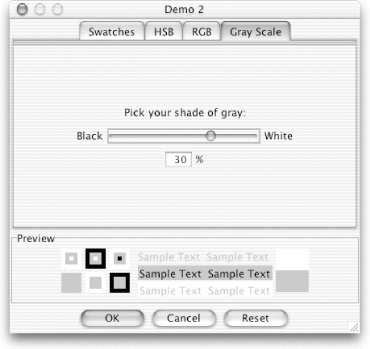12.5 Developing a Custom Chooser Panel
| If you look at the JColorChooser component, you'll realize that it is really just a tabbed pane with a color previewer below it. You can have as many chooser panels in it as you like. Let's take a brief look at a panel that can be added to a color chooser. We'll create a simple panel for selecting a shade of gray with one slider rather than pushing each slider for red, green, and blue to the same value. Figure 12-8 shows the resulting panel; its source code is presented here. // GrayScalePanel.java // A simple implementation of the AbstractColorChooserPanel class. This class // provides a slider and a text field for picking out a shade of gray. // import java.awt.*; import java.awt.event.*; import javax.swing.*; import javax.swing.event.*; import javax.swing.colorchooser.*; public class GrayScalePanel extends AbstractColorChooserPanel implements ChangeListener, ActionListener { JSlider scale; JTextField percentField; // Set up our list of grays. We'll assume we have all 256 possible shades, // and we'll do it when the class is loaded. static Color[] grays = new Color[256]; static { for (int i=0; i<256; i++) { grays[i] = new Color(i, i, i); } } public GrayScalePanel( ) { setLayout(new GridLayout(0, 1)); // Create the slider and attach us as a listener. scale = new JSlider(JSlider.HORIZONTAL, 0, 255, 128); scale.addChangeListener(this); // Set up our display for the chooser. add(new JLabel("Pick your shade of gray:", JLabel.CENTER)); JPanel jp = new JPanel( ); jp.add(new JLabel("Black")); jp.add(scale); jp.add(new JLabel("White")); add(jp); JPanel jp2 = new JPanel( ); percentField = new JTextField(3); percentField.setHorizontalAlignment(SwingConstants.RIGHT); percentField.addActionListener(this); jp2.add(percentField); jp2.add(new JLabel("%")); add(jp2); } // We did this work in the constructor, so we can skip it here. protected void buildChooser( ) { } // Make sure the slider is in sync with the other panels. public void updateChooser( ) { Color c = getColorSelectionModel( ).getSelectedColor( ); scale.setValue(toGray(c)); } protected int toGray(Color c) { int r = c.getRed( ); int g = c.getGreen( ); int b = c.getBlue( ); // Grab the luminance the same way GIMP does. return (int)Math.round(0.3 * r + 0.59 * g + 0.11 * b ); } // Pick a name for our tab in the chooser. public String getDisplayName( ) { return "Gray Scale"; } // No need for an icon public Icon getSmallDisplayIcon( ) { return null; } public Icon getLargeDisplayIcon( ) { return null; } // Finally, update the selection model as our slider changes. public void stateChanged(ChangeEvent ce) { getColorSelectionModel( ).setSelectedColor(grays[scale.getValue( )]); percentField.setText("" + (100-(int)Math.round(scale.getValue( ) / 2.55))); } public void actionPerformed(ActionEvent ae) { int val = 100 - Integer.parseInt(ae.getActionCommand( )); getColorSelectionModel( ).setSelectedColor(grays[(int)(val * 2.55)]); } } Figure 12-8. A custom chooser panel added directly to a JColorChooser object Here's the application that produced the new chooser. The only real change is that we manually build the list of chooser panels for our chooser in the ColorPicker2 constructor: // ColorPicker2.java // A quick test of the JColorChooser dialog // import java.awt.*; import java.awt.event.*; import javax.swing.*; import javax.swing.colorchooser.*; public class ColorPicker2 extends JFrame { JFrame parent; Color c; public ColorPicker2( ) { super("JColorChooser Test Frame"); setSize(200, 100); parent=this; final JButton go = new JButton("Show JColorChoser"); final Container contentPane = getContentPane( ); go.addActionListener(new ActionListener( ) { final JColorChooser chooser = new JColorChooser( ); boolean first = true; public void actionPerformed(ActionEvent e) { if (first) { first = false; GrayScalePanel gsp = new GrayScalePanel( ); chooser.addChooserPanel(gsp); } JDialog dialog = JColorChooser.createDialog(parent, "Demo 2", true, chooser, new ActionListener( ) { public void actionPerformed(ActionEvent e) { c = chooser.getColor( ); }}, null); dialog.setVisible(true); contentPane.setBackground(c); } }); contentPane.add(go); setDefaultCloseOperation(EXIT_ON_CLOSE); } public static void main(String args[]) { ColorPicker2 cp2 = new ColorPicker2( ); cp2.setVisible(true); } } |
Graphic Java 2: Mastering the Jfc, By Geary, 3Rd Edition, Volume 2: Swing
ISBN: 0130796670
EAN: 2147483647
EAN: 2147483647
Year: 2001
Pages: 289
Pages: 289
Authors: David Geary